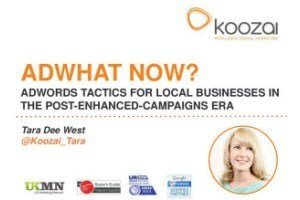 Since the launch of Enhanced Campaigns, AdWords have come under fire for becoming too expensive for small and local businesses.
Since the launch of Enhanced Campaigns, AdWords have come under fire for becoming too expensive for small and local businesses.
This presentation looks at AdWords tactics for local business, to make AdWords more cost effective so you can turn the odds in your favour again.
You can find my slides below as well as a break down of the key points:
Keyword Strategy and Account Structure
Account Structure
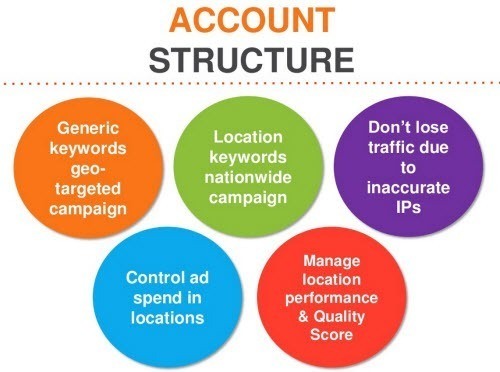
For a local business, location targeting is particularly fundamental.
I would recommend having one geographically targeted campaign, and one nationwide campaign, for each service or product range. The nationwide campaign should contain location specific keywords, such as “furniture shop Brighton”, whilst the one which is geographically targeted to the users location, can contain more generic versions, such as “furniture shop”.
This kind of account structure is really effective for local businesses, because it allows you to make sure you’re not missing out on potential traffic just because the users IP address isn’t accurate.
It is also a great way to control your spend between areas, because although we now have bid adjustments, they can’t control what proportion of the spend goes to which areas, they simply determine bids not budget. This kind of account structure means that if the campaign targeting Brighton geographically tends to convert better than the other campaign, you can control exactly how you split your daily spend between the campaigns.
To create this account structure, simply use AdWords Editor to copy your existing generic campaign and then append all the keywords with the location you are targeting.
Bid on Your Brand Name
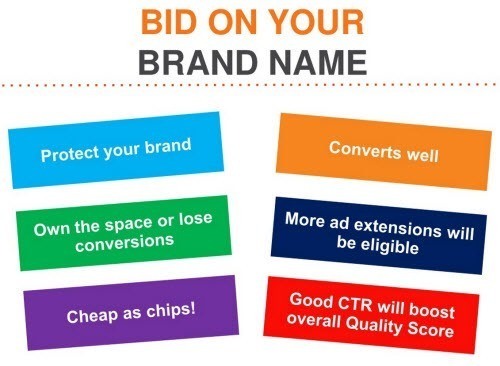
Bidding on your brand name is fundamental, but it’s surprising how often people forget to do it!
There are a few studies which suggest that even if you rank first organically for your brand, and you choose not to bid on it in PPC, you will lose conversions. This is because if you are not in the ad space for your brand name, someone else will be! The user will see their result before yours and may click it, rather than scrolling down the page to your organic result.
The Cost per Click for your brand name will be very low, because it’s highly relevant to your website, and the conversion rate is usually really strong, because users who search for your brand already have a clear interest in you over other companies offering the service.
If you are a small business with a limited ad spend, I would advise against bidding on any competitors brand names. This is because they will have high CPCs and the likelihood of them generating conversions is low. In addition to this, their Click through Rate will be extremely poor (often because your average position will be limited, but also because your site is not as relevant). Having a low overall CTR in even one campaign can negatively affect the Quality Score of your overall account, which might result in higher CPCs in other campaigns.
Use Modified Broad Match
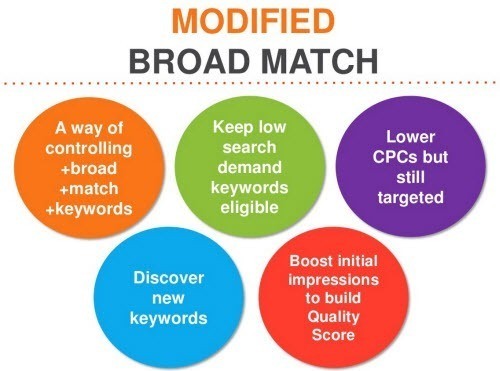
Modified Broad Match is a way of controlling broad match keywords, by adding a plus symbol (+) to the front of any individual word in the keyword string that tells Google this word must be part of the search query. The keyword can then be triggered by any search term which includes the words marked with a + and any or none of the other keywords, in any order and with misspellings and plurals.
You might have noticed that Google are now marking some keywords as ineligible to go to auction simply because they have low search demand. If you have keywords experiencing this, try adding them as modified broad match keywords and generally they become eligible again.
Another good reason to use modified broad match is to get your impressions up when you initially start a campaign. When a campaign first goes live, its quality score is based on the industry average, until your keywords gain a significant number of impressions. Modified broad match allows you to accumulate these impressions whilst still having control over the targeting and relevancy to build a good CTR.
The other benefits of modified broad match is that it allows you to find new keyword ideas without letting standard broad match keywords run away with your budget. It can also be cheaper than standard broad match.
Bidding Strategy
As a small business wanting to save time and resources, it might be tempting to rely on AdWords automated bidding strategies, but please don’t!
Bid Adjustments
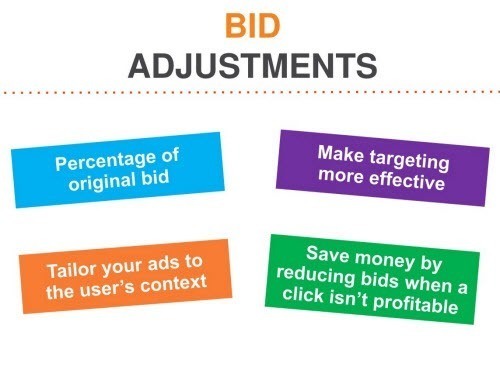
I’m sure you’re all aware of what bid adjustments are, but just in case any of you aren’t, they are a percentage adjustment of your original bid. You can set bid adjustments within the AdWords interface to target the users context, including their location, time of day and device.
Location Bid Adjustments
Google have positioned location bid adjustments as a really handy feature for local businesses to bid up for the locations where they convert best. This is true in some respects, but it’s also a nice little money maker for Google because you’ll be increasing your bids where you may not have otherwise, and advertising costs will increase as a result.
It’s important to remember that location is something which is taken into account when Google determines your Quality Score. It is considered at account level, so it’s an average of how your ads perform in geographical locations overall.
You can use location bid adjustments to manipulate this and help combat any low quality score areas.
Use the data in the dimensions tab to see where your campaigns have the lowest CTR, and set a bid adjustment to increase your bids slightly for those areas. That will increase your average position, which will also combat the lower CTR so your Quality Score is not affected as much. If these areas have a low CTR and they tend not to convert, or you can’t afford to increase your bids any higher, I would recommend actually excluding them completely as locations, so that they still don’t have a negative effect on your overall Quality Score.
Scheduling Bid Adjustments
Just like with location bid adjustments, scheduling bid adjustments can also be used to combat any times of poor CTR performance which might otherwise affect your Quality Score.
It’s done in much the same way as with location bid adjustments, using data from the dimensions tab to form your decisions.
I’d say it’s also important to remember that if there are particular times of day, or days of the week, that your account performs particularly poorly, then you should consider stopping your ads running at all during those times by adjusting your scheduling.
Don’t fall into the trap of decreasing your bids at these times, because it will only result in an even lower CTR, which will negatively affect your Quality Score and may see you paying more overall, which is not ideal for any business, let alone smaller businesses with limited budgets.
Device Bid Adjustments
As a consumer, there’s nothing more frustrating than clicking a PPC ad from your mobile, and landing on a site which isn’t mobile enabled. I’m sure you’ve all experienced it? So why as marketers do we make these same mistakes! The first thing to remember about bidding on mobile devices, is that you don’t have to! Many local businesses worry that not targeting mobile devices means that they will miss out on traffic, but what use is that traffic if your site isn’t mobile optimised and the visitor can’t complete a conversion? Ensure your site is mobile optimised and the user journey on a mobile phone is smooth and intuitive.
Set your mobile bid adjustments at ad group level. This allows you to be more granular with your bids and have greater control, so you don’t inadvertently drive up your own advertising costs where there is no real need.
When selecting how much to set your mobile bid adjustments at, consider your current CPC for mobile devices and how well they perform. Use the segment function in AdWords to see your ad group’s average positions on mobile devices and judge whether the mobile bid adjustment needs to be higher to help the average position reach two or above, or if you can reduce bids slightly to trim spend.
As a general rule, your mobile bid adjustments should always be cheaper than your desktop bids, so an average starting point would be -30%. Keep an eye on your mobile performance and tweak your bid adjustments at ad group level based on how they are performing.
Weather Bid Adjustments!
Weather bid adjustments are just one very cool use for AdWords Scripts. If you haven’t discovered AdWords scripts yet, I’d really recommend looking into them as there are lots of really useful alerts and ways of automating processes within your account which can save you a lot of time.
As a local business, you might find that weather affects how well your business converts. If this is the case, you can set up a script to increase your bids dependent on the weather forecasts. With a bit of customisation, you can also do things like show different ads when it’s raining, to when it’s sunny.
For example if you were a restaurant, you can promote your summer smoothies when it’s sunny, or your foamy hot chocolates when it’s cold outside!
It’s really easy to set up – I have very little technical knowledge but I managed to do this really easily. A link to the script can be found in the resources slide of this presentation, and all you need to do is copy a Google doc which details the location you are targeting and then paste a link to it within the code and then apply the code in the bulk operations AdWords Script section of your AdWords account.
Proceed with a little bit of caution
Please be aware that all bid adjustments stack on top of each other. If your original desktop bid is £1, and you bid an additional 10% for the area of Brighton, your bid would be £1.10. If you then also set a bid adjustment of +10% for the time period of 1pm to 2pm, your bid would be £1.21.
Review your bid adjustments with Google Analytics Bid Adjustments Report
As a local business, you might find that a contact form submission isn’t the only indication that your traffic is relevant and converting. You might also take into account other metrics such as time on site, average pages per visit as ways to determine whether your AdWords traffic is successful.
The Bid Adjustments report in Google Analytics allows you to see how your traffic is performing alongside the bid adjustments you have set for location, scheduling and devices. The report can be found within the Advertising section of Google Analytics.
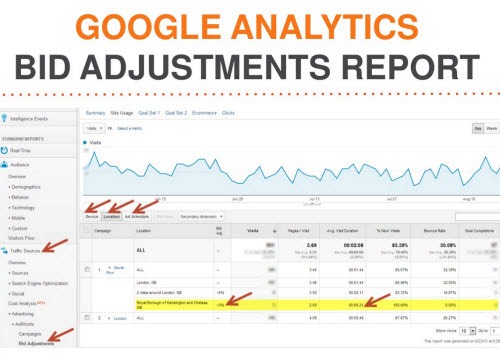
In the example used in my slides (above), you can see that the area of Chelsea where we have a bid adjustment of +3% actually performs quite badly, with a much lower time-on-site than other locations. As a result, I would remove this bid adjustment, and possibly exclude the area of Kensington and Chelsea if it continues to perform poorly.
Although you can get most of this data in AdWords in one form or another, using Google Analytics allows you to see the data in line with your adjustments and can also be used to explore ecommerce values in more detail.
Tips and Tricks!
Sustaining Your Average Position
Sustaining a strong Average Position is important for all AdWords accounts, and it’s a great way to make your account more cost effective which is particularly beneficial to local businesses with limited AdWords budgets.
The average position that is displayed in your account, is not actually your true average position. The average position in your account is only the average position when your ads have been eligible to run. This means, if you have any instances where your keywords were simply not eligible to go to auction because of low bids or relevance, they have a negative influence on your Quality Score.
To counter this, you should add a column to your keyword table to view Lost Impression Share Due to Rank. If your keywords are losing impression share due to rank it means that they aren’t eligible for every opportunity to show because their ad rank isn’t high enough all the time. This might be an issue with relevancy and Quality Score, so review these keywords and ensure their ad text and landing page along with other Quality Score factors are all in place. If they are as relevant and the Quality Score is as strong as possible, you can try increasing your bids at keyword level for any keywords where more than 5% of impression share is being lost due to rank.
Combating low impression share keywords will increase your overall Quality Score, boosting your ad rank and average position, so that eventually your overall CPCs may decrease.
Controlling your Ad Spend
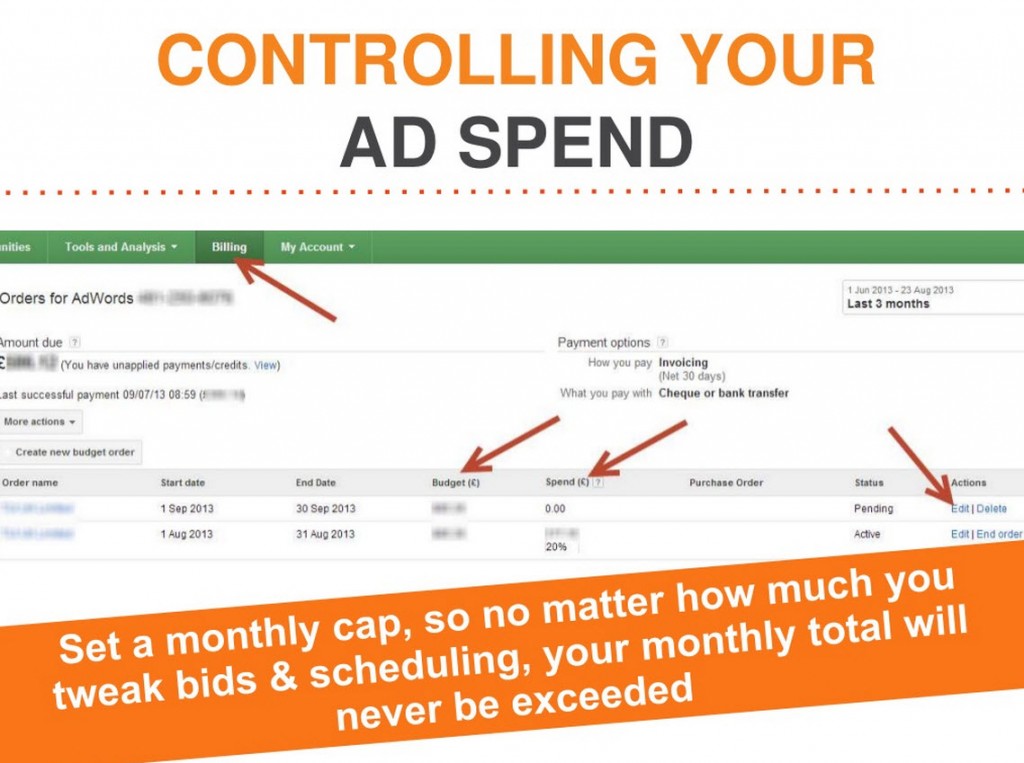
If you use monthly invoicing as your payment method, you can set monthly billing caps for your AdWords account.
This means that regardless of how much you tweak your scheduling and daily budgets, your account will stop spending when it reaches that limit.
Be aware that when your account reaches the monthly limit, your ads will simply stop showing and you won’t receive a warning, so keep an eye on this limit, or set up an AdWords Script to alert you when clicks drop. That’s a handy script to have anyway!
Bespoke Location landing Pages
Bespoke landing pages are a great way to not only improve your relevance for Quality Score, but also increase your conversion rate.
Create landing page for all the main areas you offer each product or service in. The page should contain content bespoke to that location, so it is really relevant to your keywords and the users search queries.
Follow best practice UX and CRO principles, and make sure you have a strong call-to-action or contact form on the page.
If the pages are specifically for PPC, be sure to exclude them from being indexed using your robots.txt or a no index meta tag.
Blocking Competitor IP Addresses
We all get ideas from our competitors, but you can hide your own ideas and ad text by blocking their IP address.
Find the IP address of their site using a tool like Whois. if you can get an email from them, you can also easily find the IP address of where the email was sent from, which will help further block them as it’s rare that someone works off the same IP address which their website is hosted on.
Google Grants for Non-Profits
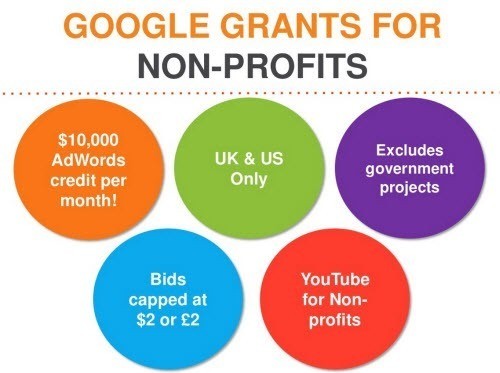
If you are a non-profit charity organisation, you may be eligible for a free £10,000 (or $10,000) monthly grant from AdWords. This translates as AdWords credit to that amount! The main draw-back is that your bids will be capped at £2 or $2 dollars maximum, however there are lots of other ways to optimise your account to increase relevancy and Quality Score so lower bids are less of a limitation.
Google grants are only eligible for those in the UK, and exclude government organisations.
Ad Extensions
Now you have optimised your account so your ads have a strong Quality Score and average position, you can really make the most of them using ad extensions.
Ad extensions massively improve CTR (up to 20% in some cases), and they are a great way to drive additional user engagement beyond the click, whilst still paying the same cost as a click.
Extensions I’d particularly like to draw your attention to as local businesses are:
Review Extensions
These are in beta at the moment, but are certainly one to keep an eye out for, or contact your AdWords rep to get whitelisted to trial the beta.
They allow businesses to show a 67 character review alongside their ad, which links to the review publication. If a user clicks the review link, the click is of no cost to you as the advertiser, as it goes to the review website.
All reviews must be published on established and reputable websites (although Google have not yet given a definition of what comprises this).
Review extensions are awesome for local businesses and services, because previously the only kind of consumer rating extension was Seller Ratings, which were only applicable to those using Google Shopping (which most local businesses aren’t).
Email Extensions
Setting up Email Extensions (or Communication Extensions as AdWords have vaguely named them), will see fantastic results on brand AdWords campaigns.
The nature of a brand campaign means that users are happier to give up their email address in exchange for offers, promotions or news because they trust your brand name.
The email addresses are collated in a Google Doc, where they’ll be stored for 60 days only, so remember to export them regularly.
Contact your AdWords rep to set email extensions up, and be sure to have your Privacy Policy updated so that it states your use of the email addresses.
Image Extensions
Image extensions are a great way for local businesses to get visual within paid search results, to rival ecommerce sites who have Product Listing Ad images brightening up their ad space. They perform particularly well if your service is highly visual such as holidays or property.
You’ll need to make sure your Image Extensions are relevant to everything in your ad group, as they are applied at ad group level and AdWords are very strict on their relevancy guidelines. Company logo images simply won’t cut it, and neither will images with lots of white space or text on them.
Offer Extensions
You might think you don’t have anything that would count as an offer to be used in Offer Extensions if you don’t offer product or service discounts or promotions, but you’d be surprised. Do you offer free whitepaper or resource downloads? Free site audits? Free valuations? Free consultations? Free call-outs? Free delivery? Even free bespoke quotes can be used as an offer extension. When you set them up, choose the ‘text’ option instead of offer code and simply write what your offer is and link to it if required.
Offer Extensions were originally designed to encourage footfall into physical stores, for example by a local business offering 10% off a lunch when the user prints off the offer and comes into store. With this in mind, it might not be too long until AdWords clamp down on what is acceptable to be used as an offer, but for now I’d recommend trying your luck as almost anything can pass as an offer!
So Much More Than Search…
If these tips and tricks still aren’t enough to keep AdWords PPC cost effective for your local business, you could always consider other kinds of AdWords advertising which can be much cheaper. Remarketing is fantastic as a brand building form of advertising, as well as for driving a strong level of view through conversions. If you have an ecommerce website, you should take a look at product listing ads as the CPC is generally lower than standard search CPCs in my experience, and the ad space is much more appealing than standard PPC ads.
You should now have some useful tips and tricks to ensure your AdWords account is as cost effective as possible and performs to it’s full potential. If you have any other ideas you’d like to share or any questions please leave a comment below.
Leave a Reply